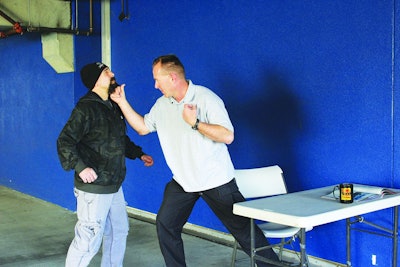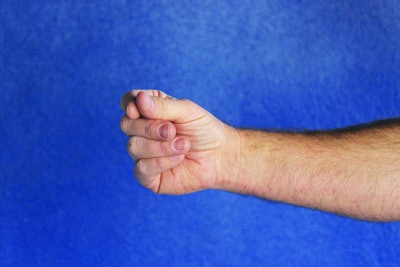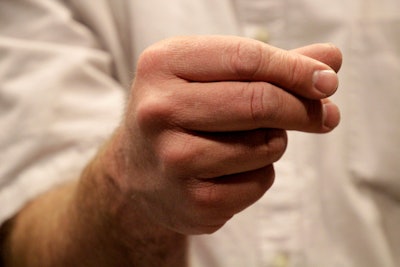If a suspect suddenly turns violent and you are in an awkward position such as writing a ticket or drinking a cup of coffee at a coffee shop, you may need to punch that suspect with your fist. This is not a boxing match. You want to end the fight as quickly as possible, and your best technique for ending the confrontation with one punch without hurting yourself is a modification of the Kuta punch that I call the Wolverine punch.
 The Wolverine punch can be executed easily as you arise from a seated position. This is much better than waiting to stand up and then punching your attacker. (Photo: Al Abidin)
The Wolverine punch can be executed easily as you arise from a seated position. This is much better than waiting to stand up and then punching your attacker. (Photo: Al Abidin)
Named for the Marvel superhero with metal claws in his fists, the Wolverine punch is a jackhammer, jab-style punch that is quick, powerful, and less likely to break your hand than a straight punch.
The metacarpal bones in the puncher's hands are commonly broken when a fist lands wrong. By using the Wolverine punch, you protect the metacarpal bones in your hands three ways:
* Your phalanges, the bones in your fingers, are held in a way that doesn't cause your metacarpal bones to flex and break in the boxer's fracture.
* Your punch will penetrate three inches and then quickly be pulled back similar to the down-and-up motion of a jackhammer. This avoids rebound force, which could bend and break one of your metacarpal bones.
* Your wrist stays in a neutral position so that it decreases the chances of bending and breaking your metacarpal bones.
Making the Fist
To make the Wolverine fist, touch your thumb with your pointer finger as you raise your hand to punch. Your other fingers should be underneath them. They are still, but not clenched. This helps you punch with just your two center knuckles, giving you seven times more breaking force than a tight fist. Greater breaking force makes it more likely you'll break the suspect's bones. But the Wolverine punch helps you avoid the hand injuries that can happen when using a tight fist.
Here's a table that compares the breaking force of a tight fist to a Wolverine punch.
| Fist Type | Contact Area | Results* |
| Tight fist | 8 square inches | 25 PSI |
| Wolverine punch |
1.1 square inches 87% smaller surface area |
182 PSI 728% more breaking force |
* Calculation uses a bodyweight of 200 pounds and assumes that you are hitting with all your weight.
Beyond providing more breaking force, the Wolverine punch helps you avoid breaking your hand, specifically, a metacarpal bone. You'll hit with the end of the bone, instead of the weakest point, the middle.
You'll also react more quickly to defend yourself because the Wolverine punch can be formed more quickly than a standard fist. This is crucial, especially on the street where you're likely to face more than one suspect.
 The Wolverine punch is a variation of the Kuta punch that can be delivered quickly to great effect and with minimum risk of damaging your own hand. Because the force is so focused at impact it's much more powerful than a tight fist. (Photo: Al Abidin)
The Wolverine punch is a variation of the Kuta punch that can be delivered quickly to great effect and with minimum risk of damaging your own hand. Because the force is so focused at impact it's much more powerful than a tight fist. (Photo: Al Abidin)
Penetrate and Return
Take full advantage of the Wolverine punch by penetrating the target three inches. This will help you be effective enough to stop someone with one punch.
But remember to instantly whip your punch back away after penetrating three inches. This allows all your force to go into the suspect without it returning into your arm. When you do this right, you'll feel very little if any force going back into your arm.
This is what I call the "jackhammer principle," and it provides the power that when combined with the smaller surface area of the Wolverine punch creates maximum breaking force. I say jackhammer because your fist will make very brief contact with the target.
When delivering the Wolverine punch, be sure to keep your wrist straight and tight to support the greater breaking force. Also keep your elbow pointed down to center your bodyweight behind your punch. These two things will help you avoid injuring your wrist.
From Any Position
In addition to protecting your hands and wrists, the Wolverine punch, because it can be delivered so rapidly and with so much force, can quickly end a fight. Even if there's more than one suspect, it increases your chances of prevailing because it can be delivered so quickly.
Critical for law enforcement officers is the fact that the Wolverine punch is effective even if you aren't standing. The Wolverine punch gives you the ability to quickly respond from any position. For example, if you're sitting at a table with your hands resting on the table, you can use the Wolverine punch to go directly into an offensive move. One of your hands will move to generate quickness while the other goes directly from the table to punch the suspect's head. There's no wasting time by getting into a stance with your fists up. This would just allow the suspect to deliver multiple punches before you got to your feet, if you even made it to your feet. Forget about getting to your feet before punching. Punch him as you're standing up. (If he's too tall, punch him in the stomach and then the face.)
 The Wolverine Punch seen from the front. (Photo: Al Abidin)
The Wolverine Punch seen from the front. (Photo: Al Abidin)
Keep in mind that your body will spin on a vertical axis to come across with your punch. Then be ready to follow with more punches, in case the suspect doesn't go down or in case there's more than one.
Speed is critical so I'm including a streamlined and updated form of F.A.S.T., a drill I discussed in "Increasing Speed and Power," (POLICE, April 2017) to help you use your startle reflex for the speed and power you'll need to end the fight with one punch. See "The F.A.S.T. Drill," below.
Don't Telegraph
Quickly look at the area you will punch, right before doing so. But don't telegraph your punch to the suspect. When you look at a target area, instantly punch it. He won't have time to respond.
Another benefit of the Wolverine punch is that it provides three inches more reach than an open palm strike, allowing you to stay farther away from the attacker. The open palm works well at closer range, but it doesn't have the effect of the Wolverine punch.
Al Abidin began self-defense training in 1981. His experience includes teaching, speaking, and writing for the law enforcement community. Abidin's self-defense training videos are available at www.AlAbidin.org.














